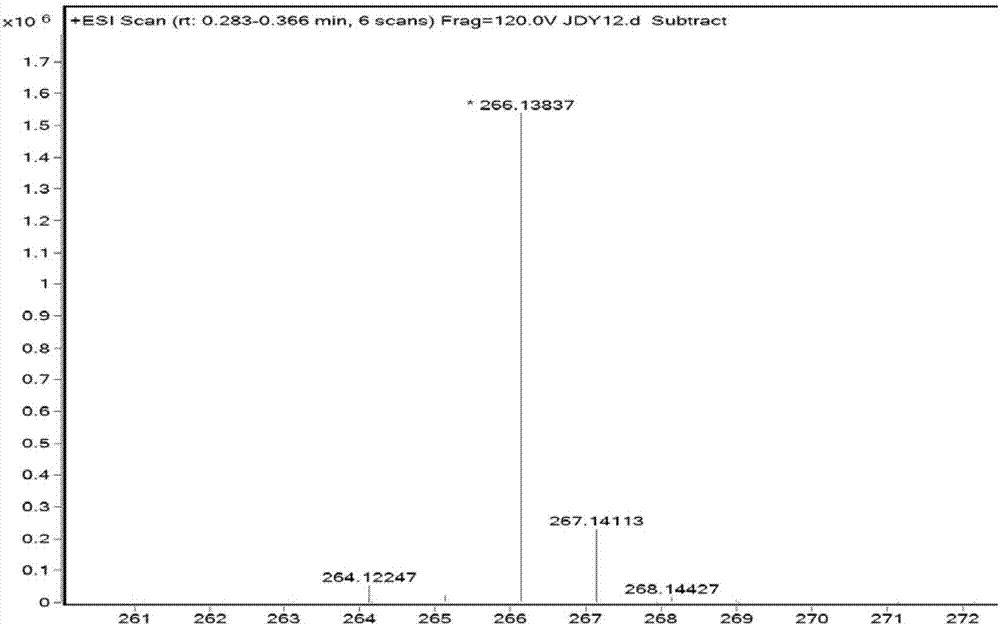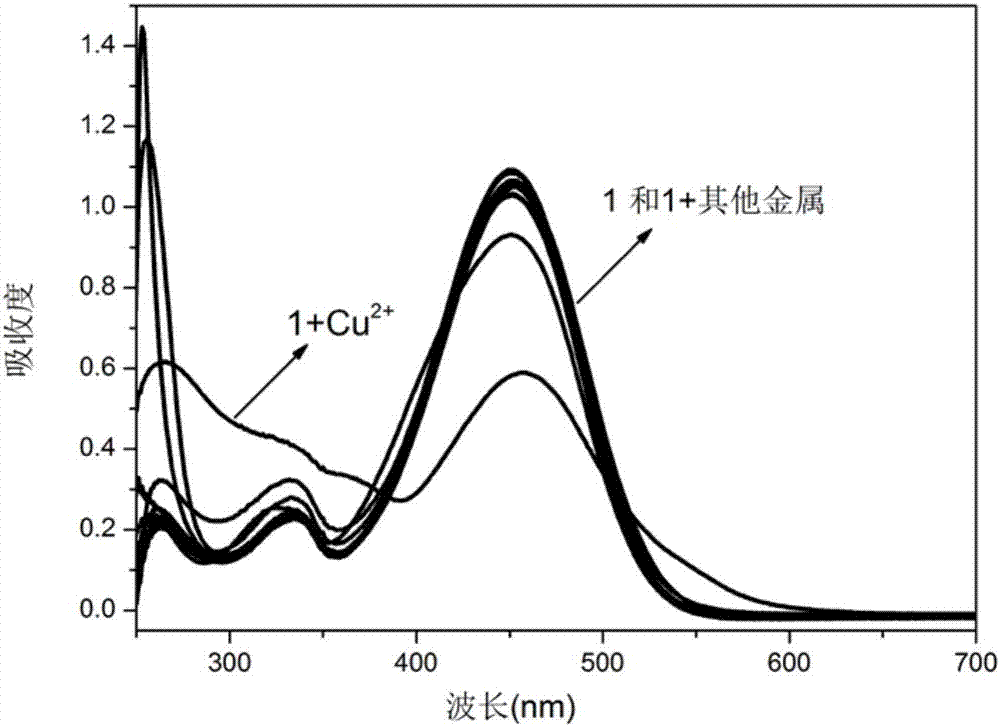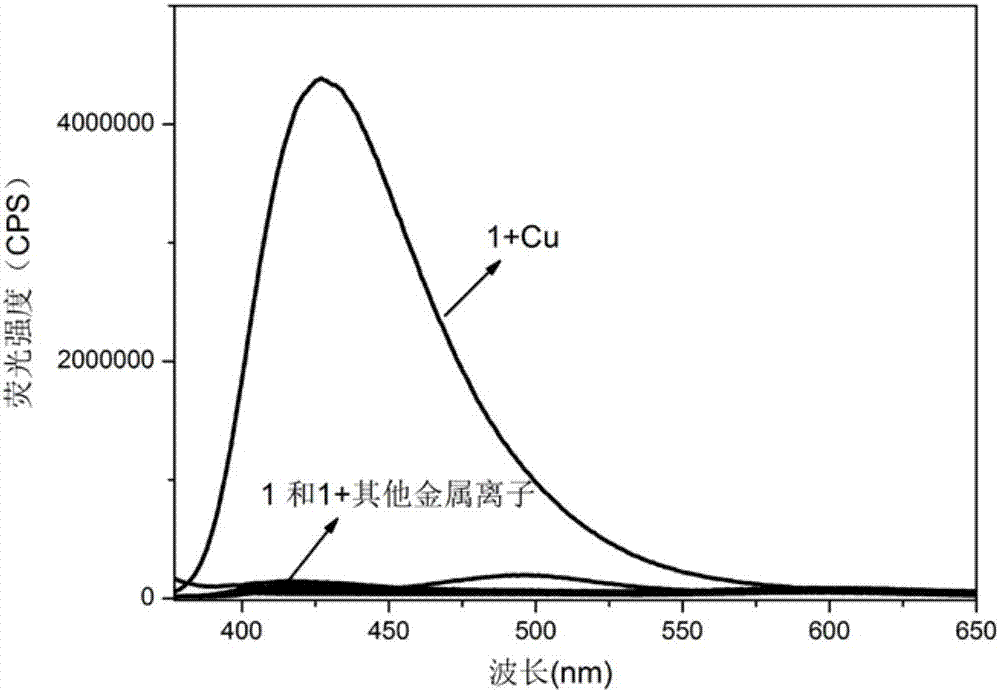Schiff base multifunctional fluorescence probe, and preparation method and application thereof
A fluorescent probe and multi-functional technology, applied in the field of fluorescent probes, can solve problems such as environmental pollution, and achieve the effects of strong operability, simple preparation process, and cost-saving testing
- Summary
- Abstract
- Description
- Claims
- Application Information
AI Technical Summary
Problems solved by technology
Method used
Image
Examples
Embodiment 1
[0022] The preparation method of the Schiff base multifunctional fluorescent probe of the present invention comprises the following steps:
[0023] Weigh 0.4g (2.283mmol) of p-dimethylaminoacrolein, dissolve it in 10mL of absolute ethanol, stir vigorously at room temperature, and weigh 0.4935g (4.566mmol) of diaminomaleonitrile, dissolve it in 10mL of absolute ethanol, set In the constant pressure dropping funnel, slowly drop into the above solution, add 2 drops of concentrated hydrochloric acid, stir and react at 80°C for 5 hours, precipitate and filter, wash with distilled water for 3 times, ethanol for 2 times, anhydrous ether for 3 times, The pure product is obtained by recrystallization with acetonitrile:methanol mixed solvent with a volume ratio of 1:4, and the yield is 73-79%. Naturally volatilize at room temperature, and obtain a single crystal after 3 days, wherein, the amount of ethanol only needs to be such that p-dimethylaminoacrolein and diaminomaleonitrile can be...
Embodiment 2
[0045] Weigh 1g (5.71mmol) of p-dimethylaminoacrolein, dissolve it in 20mL of absolute ethanol, stir vigorously at room temperature, and weigh 0.617g (5.71mmol) of diaminomaleonitrile, dissolve it in 20mL of absolute ethanol, place Add 2 drops of concentrated hydrochloric acid to the above solution in a constant pressure dropping funnel, stir and react at 70°C for 7 hours, precipitate and filter, wash with distilled water for 3 times, ethanol for 2 times, anhydrous ether for 3 times, The pure product is obtained by recrystallization with acetonitrile:methanol mixed solvent with a volume ratio of 1:4, and the yield is 73-79%. Naturally volatilize at room temperature, and obtain a single crystal after 3 days, wherein, the amount of ethanol only needs to be such that p-dimethylaminoacrolein and diaminomaleonitrile can be completely dissolved.
[0046] Performance Test 9: Fluorescent Probes for Cu 2+ selective detection of
[0047]The fluorescent probe prepared in Example 2 was ...
Embodiment 3
[0063] Weigh 2g (11.42mmol) of p-dimethylaminoacrolein, dissolve it in 35mL of methanol, stir vigorously at room temperature, weigh another 1.85g (17.13mmol) of diaminomaleonitrile, dissolve it in 35mL of methanol, and place it in a constant pressure drop In the funnel, slowly drop into the above solution, add 3 drops of concentrated hydrochloric acid, stir and react at 75°C for 6 hours, precipitate and filter, wash 3 times with distilled water, 2 times with ethanol, and 3 times with anhydrous ether. 2:3 acetonitrile:methanol mixed solvent recrystallization to obtain pure product, the yield is 73~79%, the pure product obtained is dissolved with acetonitrile:ethanol mixed solvent with a volume ratio of 1:2, placed in a beaker and naturally volatilized at room temperature , A single crystal was obtained after 3 days, wherein the amount of methanol added only needs to be such that p-dimethylaminoacrolein and diaminomaleonitrile can be completely dissolved.
PUM
 Login to View More
Login to View More Abstract
Description
Claims
Application Information
 Login to View More
Login to View More - R&D
- Intellectual Property
- Life Sciences
- Materials
- Tech Scout
- Unparalleled Data Quality
- Higher Quality Content
- 60% Fewer Hallucinations
Browse by: Latest US Patents, China's latest patents, Technical Efficacy Thesaurus, Application Domain, Technology Topic, Popular Technical Reports.
© 2025 PatSnap. All rights reserved.Legal|Privacy policy|Modern Slavery Act Transparency Statement|Sitemap|About US| Contact US: help@patsnap.com



